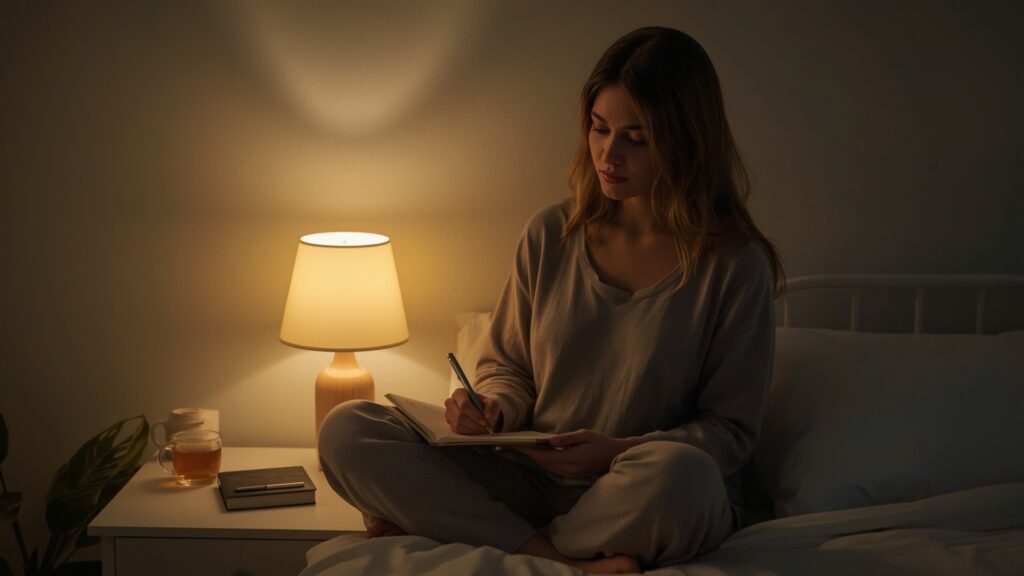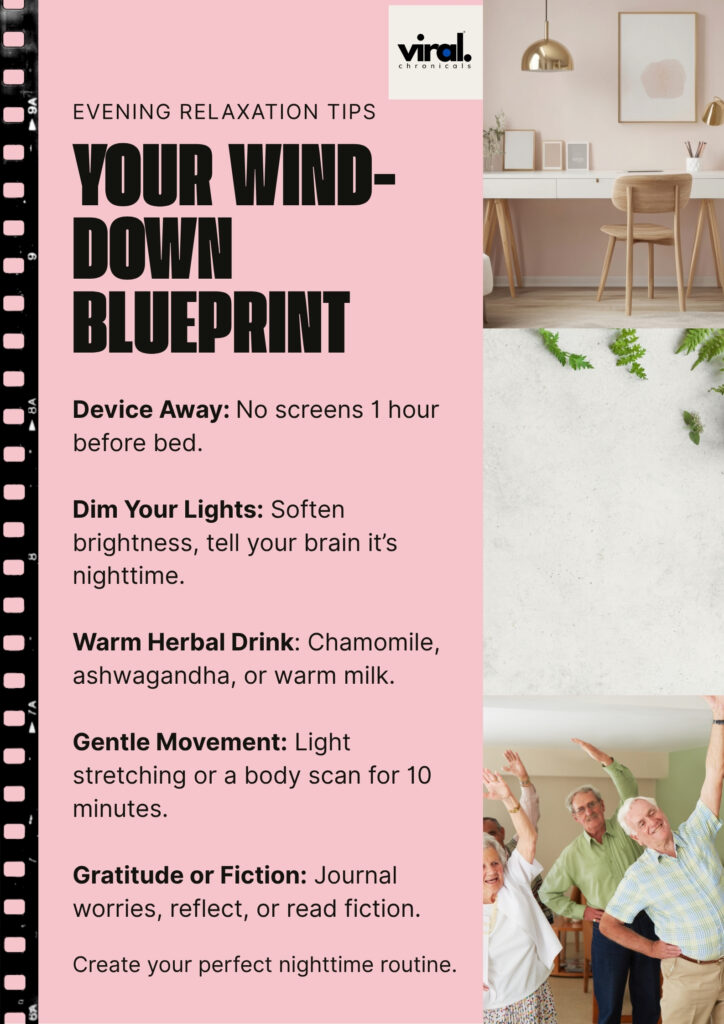My Journey from Restless Nights to Restorative Sleep
Nighttime Rituals for Better Sleep
Implementing nighttime rituals for better sleep can transform your evenings.
Creating nighttime rituals for better sleep is essential for achieving restful nights.
I used to be the person who’d lie in bed for over an hour, watching the clock tick, no matter how tired I was. My mind was busy—replaying the day, planning tomorrow. My phone would glow beside me, casting blue-light shadows on my walls. Every morning, I’d wake up groggy and half-rested, wondering if I’d ever figure out how to sleep better naturally.
Everything changed when I committed to building proper nighttime rituals for better sleep. Small, science-backed tweaks to my bedtime routine for adults made my mind slower, my body calmer, and my mornings brighter. In this article, I’ll walk you through:
- What are the most effective bedtime rituals?
- Why do they improve sleep quality?
- What’s the best wind-down routine for better sleep?
Why Evening Routines Matter: The Science Behind Winding Down
Our bodies run on a natural rhythm—the circadian rhythm. It tells us when to be alert and when to wind down before bed. But modern life (think blue-lit screens, stressful news feeds, and caffeinated late-night snacks) can mute these signals, tricking our brains into thinking it’s still daytime.
Studies show that nighttime exposure to blue light suppresses melatonin (the sleep hormone), keeps cortisol levels higher (so we feel alert instead of sleepy), and delays sleep hygiene practices kicking into gear. In sleep psychology, a wind-down routine sends strong cues to your brain and body that it’s time to “put on pajamas”—not just physically, but mentally and emotionally too.
Establishing nighttime rituals for better sleep helps signal your body it’s time to unwind.
Embracing nighttime rituals for better sleep can enhance your overall well-being.
Incorporating nighttime rituals for better sleep into your routine is life-changing.
Follow these nighttime rituals for better sleep for deeper rest.
Practice nighttime rituals for better sleep to ease the day’s tension.
Simple Nighttime Rituals Backed by Science
Let’s dive into practical, expert-approved evening habits for better sleep. Here’s what finally worked for me—plus, the science that supports each step.
Digital Detox (60 Minutes Before Bed)
“I started leaving my phone in another room—and found my mind finally quieted.”
Light stretching is one of the best nighttime rituals for better sleep.
Putting away devices an hour before bed calms your mental activity. Screens emit blue light, which is proven to delay melatonin release and keep your brain in “on” mode. Instead of endlessly scrolling, I use the last hour to reconnect with myself, letting my mind slow down the way it’s meant to at night.
Reading fiction is a great addition to your nighttime rituals for better sleep.
Warm Herbal Tea & No-Scroll Time
Journaling can be one of your nighttime rituals for better sleep.
Chamomile or ashwagandha tea is my go-to now. For those 20 minutes, I pair sips with journaling: a time to release lingering thoughts and worries instead of disappearing into TikTok. Herbal teas like chamomile have mild sedative effects, gently lowering anxiety and prepping the body for rest. The simple ritual signals “the day is ending”.
Light Stretching or Body Scan Meditation
You’d be surprised what a short, 10-minute wind-down flow in pajamas can do. Nighttime stretching or guided body scans relax muscles, lower nighttime cortisol, and make you aware of places holding tension. Each stretch and mindful breath transitions you toward restorative rest.
Reading (But No Doomscrolling!)
I keep to fiction, never news or social media. Ten pages is enough to escape reality, switch my brain from “analysis” to “imagination,” and ease myself into dreamland. Heavy non-fiction or digital content can have the opposite effect—so I leave that for daytime.
Journaling a Gratitude List
Nighttime rituals for better sleep can reduce stress and anxiety.
Implementing nighttime rituals for better sleep can transform your sleep experience.
The duration of nighttime rituals for better sleep is key for effectiveness.
Jotting down three things I’m thankful for, even on rough days, has become my last step. It gives my swirling thoughts a place to land and closes my mental tab list. Research links gratitude journaling to improved sleep quality, reduced nighttime worry, and stronger emotional well-being.

Is Warm Milk Good for Sleep?
There’s truth behind this childhood classic. Milk contains tryptophan, a precursor to serotonin and melatonin—both vital for sleep. While warm milk won’t knock you out instantly, it’s a comforting ritual that can support the psychological “time for bed” signal.
Apps can enhance your nighttime rituals for better sleep.
My 30-Minute Nightly Wind-Down Routine
Following nighttime rituals for better sleep may support those with insomnia.
After experimenting, here’s what finally helped me sleep deeper and wake up fresh:
| Time | Activity | Notes |
|---|---|---|
| 9:00 PM | Phone away, room dim | Signal to brain it’s nighttime |
| 9:10 PM | Tea + journaling | Unload thoughts, unwind |
| 9:20 PM | Light stretching | Release tension, prep for bed |
| 9:30 PM | Read 5–10 pages | Gentle transition to sleep |
Use these nighttime rituals for better sleep as your guide.
This personalized template turns my wind-down routine into a consistent habit—one my body and mind now crave, almost automatically.
FAQs: Sleep Hygiene, Rituals, and Real Solutions
How long should a nighttime ritual be?
Start with 20–30 minutes. Even short routines work, as long as you’re consistent and focus on winding down before bed.
Follow these nighttime rituals for better sleep to improve your nights.
What’s the best routine to fall asleep faster?
A simple, repeatable wind-down—free from screens, bright lights, and stressors—is key. Choose steps you enjoy (tea, stretching, reading) and use them consistently.
Is it OK to use apps like Calm or Headspace before bed?
Yes, as long as you’re not disrupted by notifications or screen glare. Guided meditation or relaxing soundscapes can ease anxiety and improve bedtime routine for adults, but keep brightness low and avoid getting sucked into device distractions.
Do routines really help with insomnia?
Research suggests that effective sleep hygiene practices and winding down before bed signal the body that it’s safe to sleep, reducing time to fall asleep and nighttime awakenings—even for people with chronic insomnia.
Join me in practicing nighttime rituals for better sleep.
Start your journey with nighttime rituals for better sleep today.
Your Wind-Down Blueprint: Print & Pin This 5-Step Plan
- Device Away: No screens 1 hour before bed.
- Dim Your Lights: Soften brightness, tell your brain it’s nighttime.
- Warm Herbal Drink: Chamomile, ashwagandha, or warm milk.
- Gentle Movement: Light stretching or a body scan for 10 minutes.
- Gratitude or Fiction: Journal worries, reflect, or read fiction.

Optional: Click the button below for a calming, sleep-optimized Spotify playlist—my go-to for soft landing into night.
Final Reflection: Simplicity Over Perfection
You don’t need a fancy sleep gadget or a ten-step checklist to reclaim your nights—just gentle, honest consistency. Whatever quietly lets your mind and body know, “It’s safe to rest,” can become your lullaby.
Why not give it a try for three nights? Let your body remember its own natural rhythm. And in the comments, please share: What’s your favorite wind-down ritual? What helps you rest? I’d love to hear your story.
Wishing you deeper, more peaceful nights—one gentle ritual at a time.
References:
American Academy of Sleep Medicine – “Practices That Improve Sleep Quality”
Sleep Foundation – “Sleep Hygiene: Healthy Sleep Habits”
National Institutes of Health – “Melatonin, Circadian Rhythms, and Sleep”


